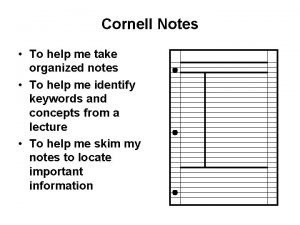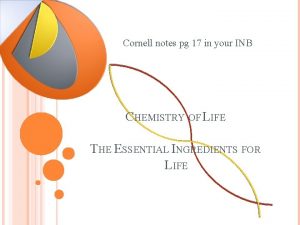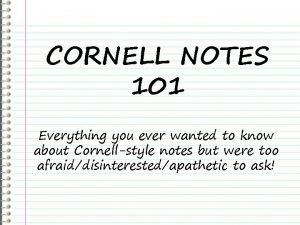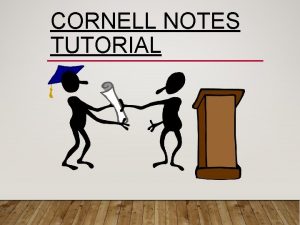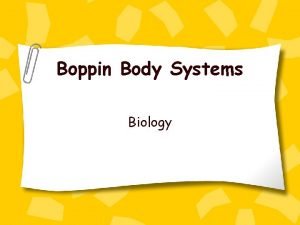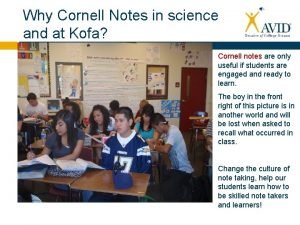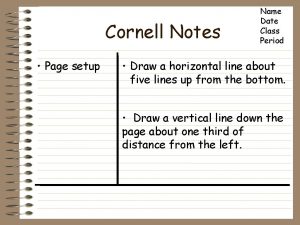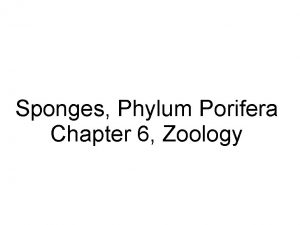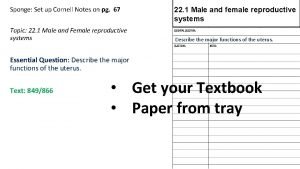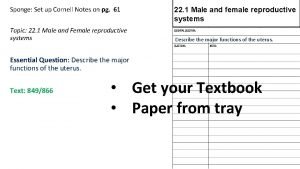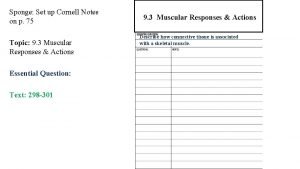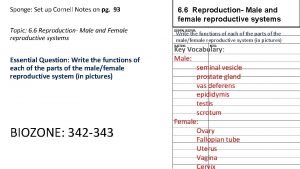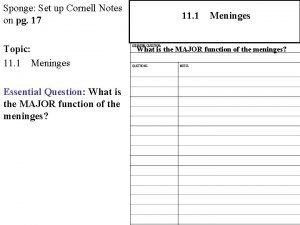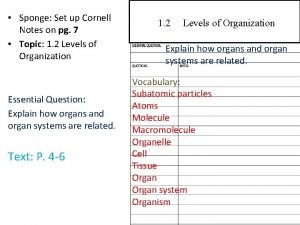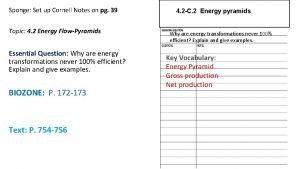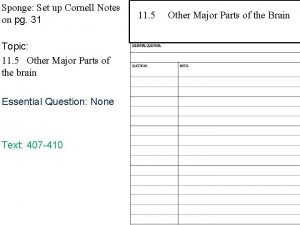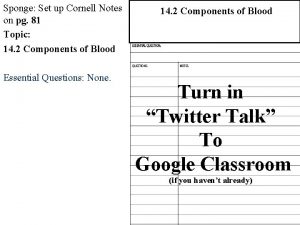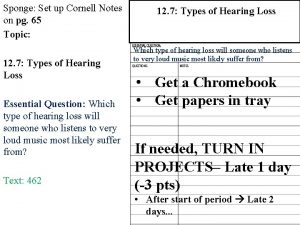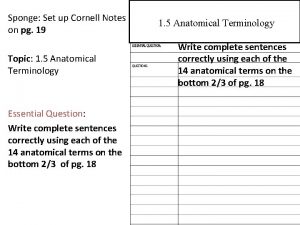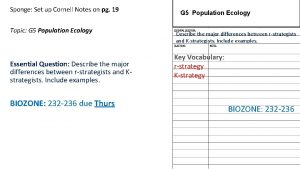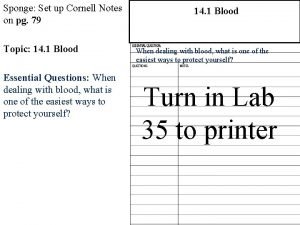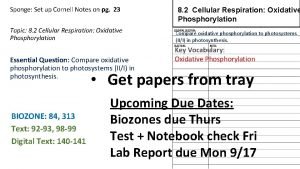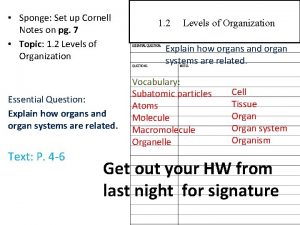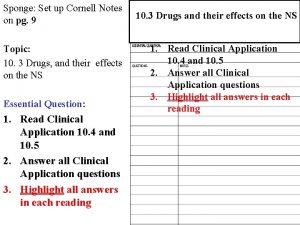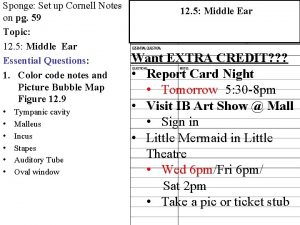Sponge Set up Cornell Notes on pg 31












































- Slides: 44

• Sponge: Set up Cornell Notes on pg. 31 • Topic: 6. 1 Skin and the regulation of body temperature Essential Question: What methods might be used to cool the skin of a child experiencing a high fever? ID the method of heat loss used for each example. Text: P. 180 -183 6. 1 Skin and the regulation of body 2. 1 Atoms, Ions, temperature and Molecules What methods might be used to cool the skin of a child experiencing a high fever? ID the method of heat loss used for each example.

p. 30 Radiation pic Conduction pic Convection pic Evaporation pic P. 3/4 Skin Video # 1 15 bullets Skin Video # 2 10 bullets 2

p. 30 Radiation pic Convection pic Conduction pic P. 2 ONLY Evaporation pic 3

Chapter 6 Skin and the Integumentary System Functions of the Integumentary System • Maintains homeostasis • Regulates body temperature • Protective covering • Prevents microorganisms from entering the body • Retards water loss • Houses sensory receptors • Contains immune system cells • Synthesizes chemicals • Excretes small amounts of waste 4

• Two or more kinds of tissue grouped together and performing specialized functions= organ • The skin is the largest organ in the body by weight 5

Skin cells • Skin cells help produce Vitamin D needed for normal bone and tooth development • Some cells (keratinocytes) produce substances that simulate development of some WBCs 6

Regulation of Body Temperature: Review • Even slight shifts can disrupt the rates of metabolic reactions • Deeper body parts should be approx 98. 6 degrees • Amount of heat loss should = amount of heat produced • Skin plays a key role 7

Regulation of Body Temperature: Review When body temperature rises…. • Nerve impulses stimulate structures in the skin and organs to release heat • Blood carries heat away • Warm blood reaches the brain and signals walls of blood vessels to relax • Deeper blood vessels contract- leading blood to the surfaceskin reddens • Heat escapes to outside 8

Regulation of Body Temperature: Review When body temperature drops… • Muscles in the walls of dermal blood vessels are stimulated to contract or become constricted • Decreases the flow of heat-carrying blood through skin • Leads to color loss • Sweat glands remain inactive • Muscle cells in the skeletal muscle contract rhythmically= shiver 9

Methods of heat production Heat is a product of cellular metabolism– thus the more active cells are the major heat producers: • Skeletal muscle cells • Cardiac muscle cells 10

Methods of heat loss—Key vocab Medium: The material or empty space through which signals, waves or forces pass The nature of the surrounding environment: • Solid • Fluid • Liquid • Gas • Vacuum (a space entirely devoid of matter---space) 11

Methods of heat loss Radiation: heat transfer of energy BY thermal radiation—No medium needed • Thermal radiation: Energy transfer by infrared heat rays which carry energy AWAY from the emitting object • Warmer objects lose heat to cooler objects • The primary means of body heat loss Draw on p. 30 12

Conduction: direct heat transfer of energy through a medium • Heat moves from the body directly into the molecules of cooler objects in contact with its surface • Less heat loss than radiation • Ex: heat moves from body INTO the seat of a chair • Will continue as long as the seat is cooler than the body touching it Draw on p. 30 13

Convection: heat transfer of energy BY a medium • Heat moves away from the source by air molecules, carrying energy with it • Less heat loss than radiation Draw on p. 30 Cooler air Movement caused within a fluid (gas/liquid) by the tendency of hotter (less dense) material to rise, and colder, denser material to sink 14 under the influence of gravity

Evaporation: When body temperature rises, sweat gland release sweat • As sweat dries, it evaporates and carries heat away from the surface Draw on p. 30 15

16

p. 30 Skin # 1 15 bullets 8 m 28 s Skin # 2 10 bullets 4 m 33 s 17

Children Die After Being Left in Hot Cars Directions: Read the article. HIGHLIGHT the answers to these questions as a way to “prove” your answer. DUE TOMORROW • Use article to answer 4 -8 • Don’t answer 1 -3 until tomorrow’s notes 18

• Sponge: Set up Cornell Notes on pg. 33 • Topic: 6. 1 Hyper/Hypothermia 2. 1 Atoms, Ions, and Molecules How would you explain to an athlete the importance of keeping the body hydrated when exercising in warm weather? . Essential Question: How would you explain to an athlete the importance of keeping the body hydrated when exercising in warm weather? Text: P. 180 -183 P. 3/4: Get out homework for signature

Hypothesize with your table: • What is HYPOthermia? • What is HYPERthermia? Can you come up with an example of each? Hint: Remember we are talking about how skin helps regulate body temperature. 20

P. 33 UNCONTROLLED Temperature Regulation Hypothermia Hyperthermia

HYPOthermia HYPERthermia HYPOthermia involves a dramatic drop in body temperature HYPERthermia involves a dramatic rise in body temperature 22

Can we think of any creative ways to remember the difference? HYPOthermia HYPERthermia HYPOthermia: Hy. PO Polar HYPERthermia: When you are hyper Hot 23

Hypothermia: body temperature drops to a dangerous level • Caused by prolonged exposure to cold • May cause mental confusion, loss of reflexes, loss of consciousness • If body core drops just a few degrees, can lead to death • Arms and legs can withstand drops of 20 -30 degrees 24

Death by Hypothermia 2 m 25

Hyperthermia: body temperature rises to a dangerous level • May occur if the temperature outside is hotter than body temperature • May gain heat from surroundings and become hotter • Can lead to fatigue, dizziness, heat exhaustion, headaches, muscle cramps, nausea, or even death 26

Hyperthermia to treat Cancer: • Long needles are put directly into the tumor • Heat is directed into the tumor • Used along with radiation and/or chemotherapy 27

Children Die After Being Left in Hot Cars Directions: Use your notes to answer the first 3 questions on your reading from yesterday. 1. What is hyperthermia? 2. How does one get hyperthermia? 3. What are the dangers of hyperthermia 28

Hyperthermia in the News: • Watch ABC News Clip: 8 Children Left in Hot Cars in August (2012) 29

30

31

32

Preventable Deaths: Leaving Children in Cars 1 m 45 s 33

Sounding the Alarm 2 m 37 s http: //www. today. com/video/new-car-seat-alerts-you-if-baby-is-left-in-car-490029635670 34

Which is Which? Use your whiteboard to tell me… HYPO or HYPERthermia? ? 35

36

37

38

39

40

41

42

43

P. 32 Using the Homeostatic response sheet on Pg. 10… Task: Write a three paragraph journal entry on either hyperthermia OR hypothermia. This is YOUR STORY: Pretend you are someone suffering from hypothermia or hyperthermia. Please write three paragraphs describing your circumstances and the effects hyperthermia or hypothermia is having on your body. Make sure to include these details: • Where are you? • What are the circumstances that led you to this fate? (Backstory) • Explain in detail the physical effects that you are experiencing. DUE: TOMORROW 44
 Susie roundpants
Susie roundpants Bikini bottom genetics worksheet
Bikini bottom genetics worksheet How to set up cornell notes
How to set up cornell notes Total set awareness set consideration set
Total set awareness set consideration set Training set validation set test set
Training set validation set test set How does cornell notes work
How does cornell notes work Cornell notes setup
Cornell notes setup What is the cornell way
What is the cornell way Cornell notes essential question
Cornell notes essential question Chemistry cornell notes
Chemistry cornell notes Walter pauk cornell
Walter pauk cornell Thinking apu
Thinking apu What does cornell notes look like
What does cornell notes look like Cornell notes for anatomy and physiology
Cornell notes for anatomy and physiology Cornell notes advantages
Cornell notes advantages Cornell note setup
Cornell note setup Cornell notes sociology
Cornell notes sociology Point of view in the interlopers
Point of view in the interlopers Cornell notes definition
Cornell notes definition Parts of cornell notes
Parts of cornell notes Cornell notes steps
Cornell notes steps Cornell notes chemistry
Cornell notes chemistry Biology cornell notes
Biology cornell notes Modified cornell notes
Modified cornell notes Cornell notes on the declaration of independence
Cornell notes on the declaration of independence Cornell notes setup
Cornell notes setup Ions and ionic bonding cornell doodle notes
Ions and ionic bonding cornell doodle notes Science cornell notes
Science cornell notes Cornell notes setup
Cornell notes setup Cornell notes setup
Cornell notes setup Metric system cornell notes
Metric system cornell notes The interlopers by saki summary
The interlopers by saki summary What does cornell notes look like
What does cornell notes look like Crisp set vs fuzzy set
Crisp set vs fuzzy set Bounded set vs centered set
Bounded set vs centered set What is the overlap of data set 1 and data set 2?
What is the overlap of data set 1 and data set 2? Fuzzy theory
Fuzzy theory Surjective vs injective
Surjective vs injective Crisp set vs fuzzy set
Crisp set vs fuzzy set Set off and carry forward of losses notes
Set off and carry forward of losses notes Conversion notes brutes en notes standard wisc 5
Conversion notes brutes en notes standard wisc 5 Sponge circulation
Sponge circulation Porifera character
Porifera character Syconoid
Syconoid Sponge and panning for gold approach
Sponge and panning for gold approach





